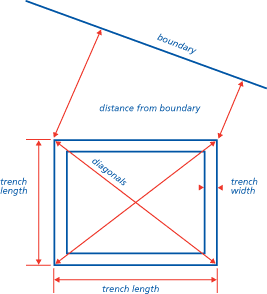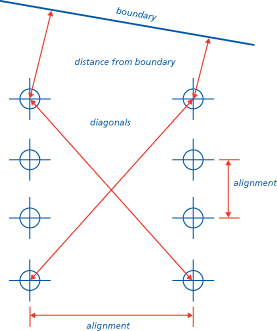4.5 Raft, pile, pier and beam foundations
SITEWORK STANDARDS
(a) meet the Technical Requirements
(b) take account of the design
(c) follow established good practice and workmanship
Sitework that follows the design and the guidance below will be acceptable for raft, pile, pier and beam foundations.
SETTING OUT FOUNDATIONS
The accuracy of setting out should be checked by control measurements of trenches, including their location relative to site boundaries and adjacent buildings. Levels should be checked against bench marks, where appropriate.
In particular, for excavations check:
- trench lengths
- trench widths
- length of diagonals between external corners.

In addition, for piles, pier and beam foundations and ground improvement techniques, check:
- spacing
- alignment
- positions in relation to the proposed superstructure.
Walls should be located centrally on the foundation, unless specifically designed to do otherwise.
Any discrepancy in dimensions, and any ground condition that causes the design to be modified, should be reported formally to the Engineer. Resulting variations should be recorded and distributed to all concerned (including NHBC).
EXCAVATIONS
Excess excavations should be avoided. Inaccuracy may prevent walls and piers being located centrally and therefore result in eccentric loading of foundations, possibly foundation failure.
To avoid damage, foundation excavation should be kept free from water (see Clause S5).
Where localised changes in strata give rise to differences in bearing capacity, reference should be made to the Engineer to ensure this has been allowed for in the design.
At soft spots, excavations should be deepened locally to a sound bottom or, alternatively, the concrete should be reinforced.
Hard spots should be removed.
Where roots are visible on the sides or bottoms of excavations (especially in clay soils), the Engineer should be consulted and the design depth modified.
Where there are, or have been, trees or hedges, foundation depth should be in accordance with the guidance given in Chapter 4.2 'Building near trees'.
Trench bottoms affected by rainwater, ground water or drying should be re-bottomed to form a sound surface.
SERVICES AND DRAINAGE
Any existing services, such as cables, water pipes or gas mains, may need to be supported and protected. Any existing drains should be diverted, or bridged, to prevent any foundation loads being transmitted to them.
Services should not be rigidly encased in concrete, masonry, etc.
Land drains should be diverted to a suitable outfall.
For relevant details, reference should be made to the Design and Sitework sections of Chapters:
5.1 'Substructure and ground bearing floors',
5.3 'Drainage below ground'
8.1 'Internal services'
Where services pass through foundations, they must not affect the ability of the foundation to carry loads.
Services should be either sleeved or passed through a suitably strengthened opening in the foundation.
In the case of drains, it is important to leave sufficient space for movement, to ensure that the drain is capable of maintaining line and gradient and any movement which may take place.
REINFORCEMENT
Reinforcement shall be clean and free from loose rust and should be placed correctly. Bars should be properly supported to ensure that the cover indicated in the design is maintained.
Bars should be secured at laps and crossings.
CONCRETING
Concreting should be carried out, as far as possible, in one operation, taking account of weather conditions and available daylight. Concrete should be placed as soon as possible after the excavation or, where necessary, after the reinforcement has been checked. Excavation and/or reinforcement may need to be approved by the Engineer or his representative, before concreting commences. In England and Wales, foundations should be approved by the person responsible for the Building Control inspections, before the concrete is placed.
Mixing, placing, testing and curing of concrete should be carried out as indicated in Chapter 2.1 'Concrete and its reinforcement' (each section) and when work is carried out in cold weather, Chapter 1.4 'Cold weather working'.
RAFT FOUNDATIONS
Raft and semi-raft foundations should be constructed in accordance with Clauses S1 to S9, as appropriate.
PILED FOUNDATIONS
Items to be taken into account include:
(a) alignment
Piles are to be vertical, unless designed otherwise.
Piles are to be installed by an appropriate specialist under the Engineer's supervision.
(b) load capacity verification
Care should be taken to ensure that the bond of beams to pads and piles is in accordance with the design and is adequate.
Test loading should be undertaken when required.
The Builder is to obtain written confirmation that the piles are suitable for their design load.
If piles are more than 75mm out of position, or out of alignment by more than 1 : 75, the Engineer should reconsider the adequacy of the foundation design.
Unless otherwise recommended by the Engineer, NHBC will expect piles which are misaligned by more than 150mm in any direction, or which are more than 5° from their specified rake, to be replaced, or additional piles to be provided in accordance with design modifications provided by the Engineer.
PIER AND BEAM FOUNDATIONS
Pier/pad and beam (and reinforced concrete strip) foundations should be constructed to meet Clauses S1 to S9, as appropriate.





















